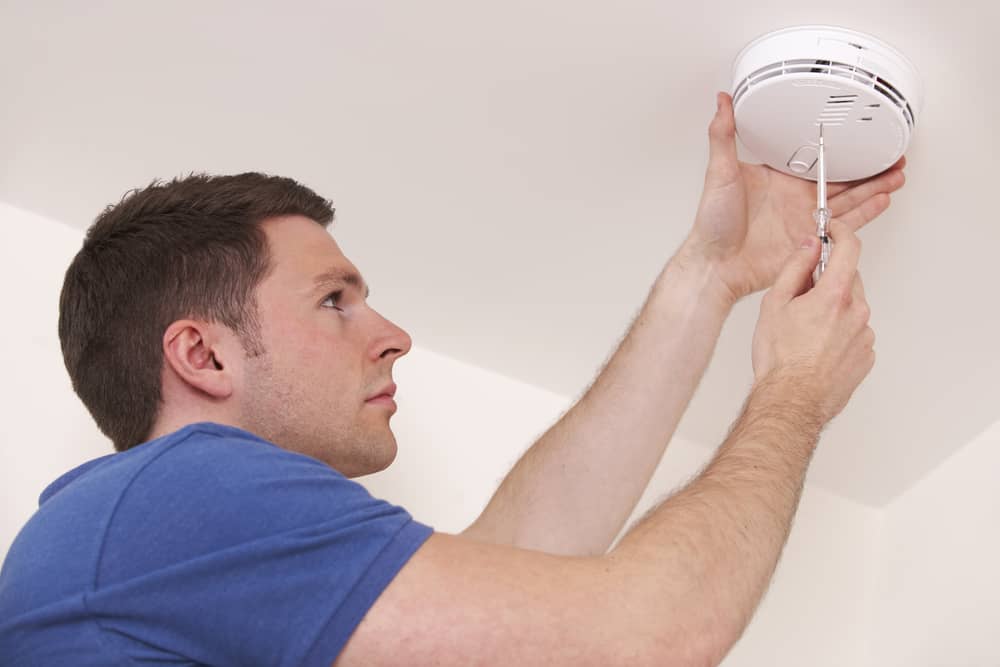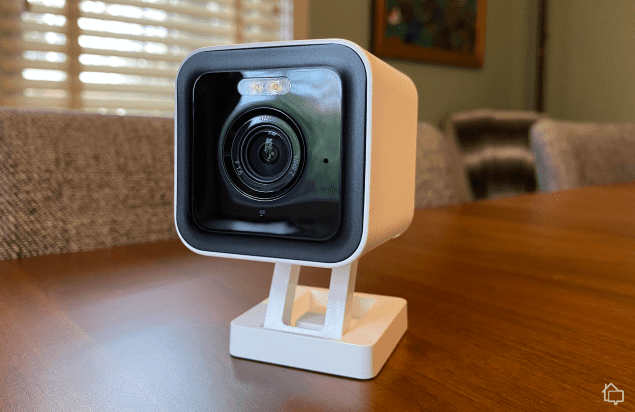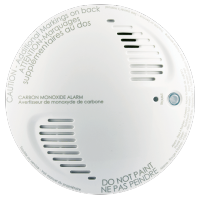A quiet night at home can turn into a scene straight out of a horror movie if you have a carbon monoxide leak that goes undetected.
Invisible, odorless, and deadly, carbon monoxide (CO) ranks up there with the deadliest toxic gasses homeowners can face. It’s so notorious because it frequently sends people to emergency rooms all around the U.S. every year, and it kills an unfortunate number of people.
Thankfully, knowing where to install CO detectors can safeguard your home and protect your loved ones. It’s a critical safety measure we strongly suggest that will hopefully keep you and your loved ones from experiencing a nightmare scenario.
Here are seven tips to help you determine the best locations for installing carbon monoxide detectors in your home, starting with the most vital.
>> Check Out: What Does a CO Detector Do, and How Does It Work?
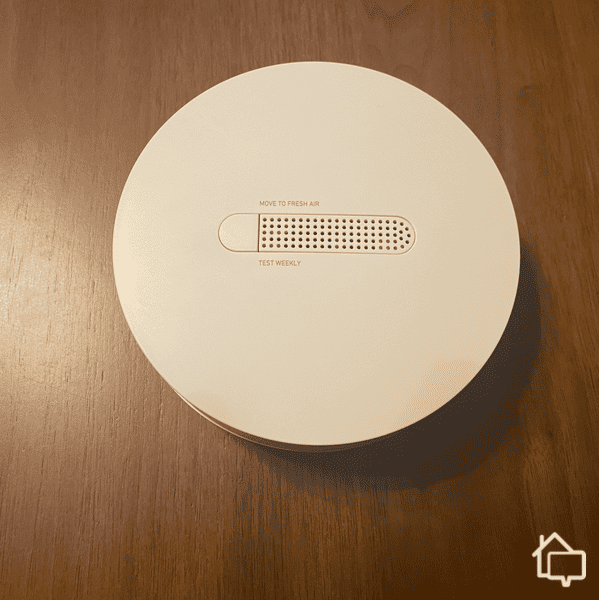
SimpliSafe’s new smoke detector and carbon monoxide monitor ready to be installed in my upstairs hallway.
1. Near Sleeping Areas
If you’re starting with one or two detectors that need to be installed, you should position the first batch in or near your bedrooms — think main hallways outside your rooms — because it’s like setting up a defense perimeter.
CO doesn’t care if you’re trying to sleep. That’s when the gas is the most dangerous, because you can’t feel its effects.
FYI: The first signs of CO poisoning typically feel like a rapid-onset flu or food poisoning: nausea, headaches, dizziness, blurred vision, vomiting, and coordination issues.1
Most research shows that you don’t need to place CO detectors down low. They can be up on ceilings or higher up in hallways. Having a defense perimeter around your bedrooms will protect you from a gas leak coming from inside your home, but if you sometimes sleep with your windows open, you may want to install detectors inside your bedrooms so you have a defense from outside sources of CO.
2. On Every Floor of Your Home
CO can accumulate on any floor of your home, so install detectors on every level of your home — including the basement — if you’re looking for comprehensive protection.
CO can come from many different sources, such as a malfunctioning furnace in the basement, a blocked fireplace on the main floor, or even a water heater in the attic. (Yes, it happens, and there may be more hidden dangers lurking in your attic besides a faulty water heater.)
Did You Know? Installing a water heater in an attic isn’t the best idea, but some homeowners don’t have any other options. Houses in certain areas don’t have or can’t have basements because of the soil, so they’re placed in either utility closets or out of sight in the attic.
If there’s a CO leak on a different level of your home and you have a detector installed only on the main floor near your bedroom, you may not realize the danger until it’s too late.
We’re going for a defense perimeter. Picture CO as an insidious killer trying to attack you from any direction it can. I have two combination smoke/CO alarms — one on my main level and one in my basement — along with one in the hallway near two bedrooms and an office.
3. Near Combustion Appliances
Faulty appliances produce a large percentage of the CO problems in a home, so be sure to place your detector at least 15 feet away from any fuel-burning appliances inside. Thit will provide protection while avoiding false alarms. Detectors placed too close to appliances can be a problem.
We’re looking at gas stoves, furnaces, water heaters, and fireplaces (many of the same appliances that cause house fires). You also don’t have to rely solely on an installed CO detector if you suspect you have a leaky appliance. Hardware stores and online retailers sell CO test kits that you can place near suspicious appliances so you can get them fixed before slapping a detector on a nearby wall.
>> Read More: Testing Your Home, Inside and Out
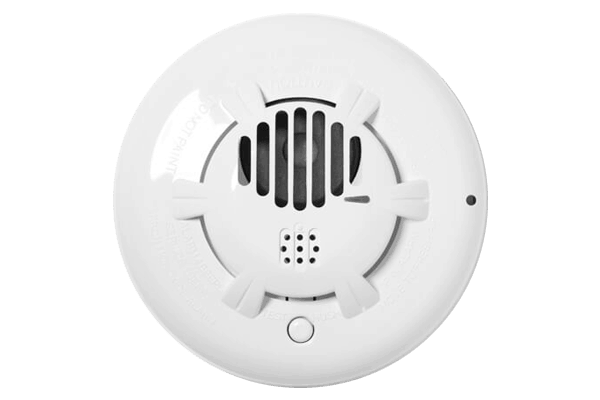
Vivint Carbon Monoxide Detector Sensor
Be sure to regularly check and maintain anything that uses combustion in your home. Consider doing a yearly maintenance and safety inspection every fall, just before the weather grows colder, or every spring, just before the weather begins to heat up — basically whenever you’re going to spend the most time indoors.
When we say “combustion appliances,” we aren’t talking portable generators, flameless chemical heaters, or grills. Those are never safe to run indoors, even if you have CO detectors in place, since they are notorious for harming and even killing people from CO poisoning. Never risk running them inside, even in an emergency such as an extreme weather event.
>> Check Out: Preparing for and Surviving an Emergency at Home
A few other tips to consider: Make sure all your combustion appliances have proper venting and that their vents are free from blockages. Never patch vents with tape, since it can cause CO to build up inside. When in doubt, have a professional check it out.
4. Near Your Attached Garage
If you have an attached garage, install a CO detector inside your home near the door leading to it. Look for a model that has an overly loud alarm so you won’t miss it when you’re indoors.
Vehicles emit CO when idling, and they can fill your living space with dangerous amounts of CO from the garage. It can even happen with the garage door open.
Placing a detector near the garage entrance in your home helps ensure that any CO buildup is detected promptly, and dust and cold temperatures from the garage won’t affect it.
If you spend a lot of time in your garage, consider installing a CO detector there as well.
5. Away From Drafts, Ventilation, and Humidity
It’s important to place detectors near potential sources of CO, but it’s equally important to avoid placing them in drafty areas, near ventilation sources, or humid areas such as bathrooms.
Air circulation can dilute the concentration of CO and affect the detector’s accuracy or cause false alarms. Humidity can be a problem as well. The increased moisture in the air can affect the detector’s sensors and cause corrosion in the internal components over time, reducing its lifespan.
Did You Know? Excessive humidity can lead to mold, and mold can, surprisingly, thrive on circuit boards and insulation. It can cause physical damage to a device’s components and potentially cause short circuits. If your home has high humidity levels, consider investing in a dehumidifier.
6. On the Ceiling or High on the Wall
Despite circulating internet myths, CO detectors can be installed on the ceiling or high on the wall for optimal performance.
CO, one of the worst hidden household dangers, is slightly lighter than air and it diffuses evenly, so placing detectors up high ensures that they can detect the gas early as it rises.
You may see stand-alone CO alarms down low in certain homes, but that’s because they’re often the plug-in variety and have a screen that needs to be read.
7. Wherever the Manufacturer Says
Manufacturers test their CO detectors to determine optimal installation under various conditions. They look at gas-dispersion patterns, airflow dynamics, and sensor sensitivities. Those, along with alarm ranges, mean they’re shooting for prime coverage of a given area.
They also consider the limitations of their products and often follow safety standards established by experts such as the National Fire Protection Association. Following their instructions will ensure you have your detectors installed in the right spots and have the most protection possible.
Most manufacturers back up their products with science and collective practices. If a manufacturer says to avoid a specific area that we suggest is a good place for installation, follow their lead.
Sleep Soundly With Proper CO Protection
CO can turn an otherwise peaceful home into a house of horrors.
Our CO detector installation tips can help protect your loved ones and enhance the effectiveness of your CO detection system. If you’re ever unsure about where to place a detector, contact the manufacturer directly for clarification.
The manufacturer that makes the detector knows its product best, and it’s best to tailor your installation to your specific detector and home layout.

